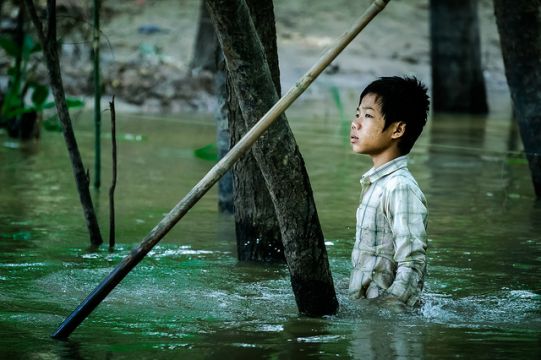Seeing climate adaptation through the eyes of a child – Mainstreaming children’s vulnerabilities and capacities into community-based adaptation to enhance impact


Mekong boy. Photo credit by Damian Bere
Recent research published in the Climate and Development journal suggests using a child-centered approach to community-based adaptation (CBA) for policy planning. Children are affected by nearly all conceivable effects of climate change. Apart from the direct physical trauma of natural disasters, the impact of climate change on children can affect their psychological wellbeing. Examples include suffering from loss of family members and emotional turmoil from increased competition for scarce resources or from the fear of climate induced migration.
“Climate change is fundamentally an issue of rights. But the views of children are rarely heard and considered in policy planning. A child-centered approach to climate change adaptation is grounded in the recognition of children’s rights and places them at the heart of the adaptation efforts and policies”, says Paul Mitchell, one of the authors.
Evidence from projects in Philippines, Vietnam, Papua New Guinea and Vanuatu shows that putting children at the centre of building adaptive capacity can have unexpected innovative outcomes, like, for instance, selling vegetables and fruits from school gardening and making cook stove briquettes from gathering combustible waste. Moreover, the use of child-centered approach can help to overcome adaptation barriers (including those based on race, class and gender) and is likely to have long term benefits for communities.
Read the full text “Mainstreaming children’s vulnerabilities and capacities into community-based adaptation to enhance impact” by Paul Mitchell & Caroline Borchard.
Climate and Development Special Issue
This article forms part of an open access special issue of Climate and Development on mainstreaming CBA into policy planning. The issue gathers experiences of CBA practitioners across different scales and sectors and highlights CBA policy planning for women, children and extremely poor. It also provides a framework for upscaling CBA finance as well as for knowledge management, and offers an outline for the use of participatory methods in order to make CBA more engaging for the urban population.
“Practitioners seldom write scientific papers, so peer-reviewed scientific literature does not reflect the wealth of their knowledge. This special issue addresses this gap, providing scientific validity to that practical experience and sharing good practices with other practitioners around the world”, says Saleemul Huq of International Institute for Environment and Development (IIED), one of the guest editors of the issue.
Some of the research in this special issue explores sector specific experience of mainstreaming CBA in agricultural development in Bangladesh, Mozambique, India and Uganda, stressing the key role of extension services and farmer organization in integration of national and local CBA policy planning.
Other analysis shows that gender sensitive policies on climate adaptation are limited and that the unique impact of climate change on women is often overlooked. Moreover, the special issue demonstrates that the high vulnerability of the extremely poor to climate change is based on power and inequality and can be addressed by influencing power relations and networks.
“Community-based adaptation to climate change is based on local priorities, needs, knowledge and capacities. But unless these bottom-up activities are ‘mainstreamed’ into larger scale policy and planning processes, they are little more than stand-alone initiatives”, says Hannah Reid (IIED), another guest editor of the special issue.
Other publications in Climate and Development Volume 6, Issue 4, 2014, special issue: Community-based adaptation: Mainstreaming into national and local planning
-
Mainstreaming community-based adaptation into national and local planning. Hannah Reid, Saleemul Huq.
-
Mainstreaming climate change adaptation into development in Bangladesh . Jessica Ayers, Saleemul Huq, Helena Wright, Arif M. Faisal, Syed Tanveer Hussain.
-
Identifying operational mechanisms for mainstreaming community-based adaptation in Nepal . Bimal Raj Regmi, Cassandra Star.
-
Farmers, food and climate change: ensuring community-based adaptation is mainstreamed into agricultural programmes . Helena Wright, Sonja Vermeulen, Gernot Laganda, Max Olupot, Edidah Ampaire, M.L. Jat.
-
Gender-sensitive adaptation policy-making in Bangladesh: status and ways forward for improved mainstreaming . Dalia Shabib, Shusmita Khan.
-
Power and differential climate change vulnerability among extremely poor people in Northwest Bangladesh: lessons for mainstreaming . Cristina Coirolo, Atiq Rahman.
-
Moving towards inclusive urban adaptation: approaches to integrating community-based adaptation to climate change at city and national scale . Diane Archer, Florencia Almansi, Michael DiGregorio, Debra Roberts, Divya Sharma, Denia Syam.
-
A review of decision-support models for adaptation to climate change in the context of development . John Jacob Nay, Mark Abkowitz, Eric Chu, Daniel Gallagher, Helena Wright.
-
Enablers for delivering community-based adaptation at scale . Elizabeth Gogoi, Mairi Dupar, Lindsey Jones, Claudia Martinez, Lisa McNamara.
-
Knowledge flows in climate change adaptation: exploring friction between scales . Clare Stott, Saleemul Huq.
-
Up-scaling finance for community-based adaptation . Adrian Fenton, Daniel Gallagher, Helena Wright, Saleemul Huq, Charles Nyandiga.
Suggested citation
Paul Mitchell & Caroline Borchard (2014) Mainstreaming children’s vulnerabilities and capacities into community-based adaptation to enhance impact, Climate and Development, 6:4, 372-381, DOI: 10.1080/17565529.2014.934775
(0) Comments
There is no content